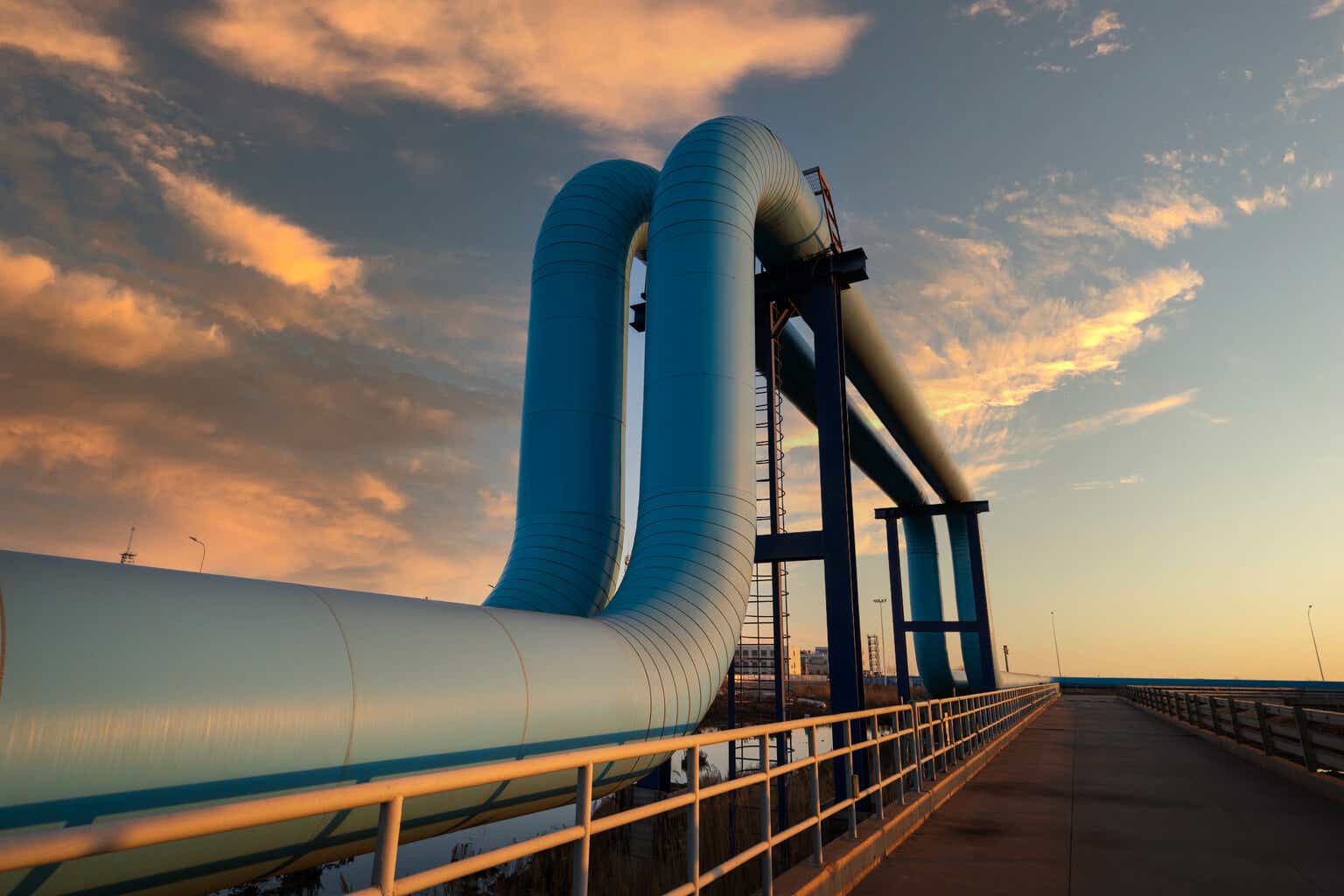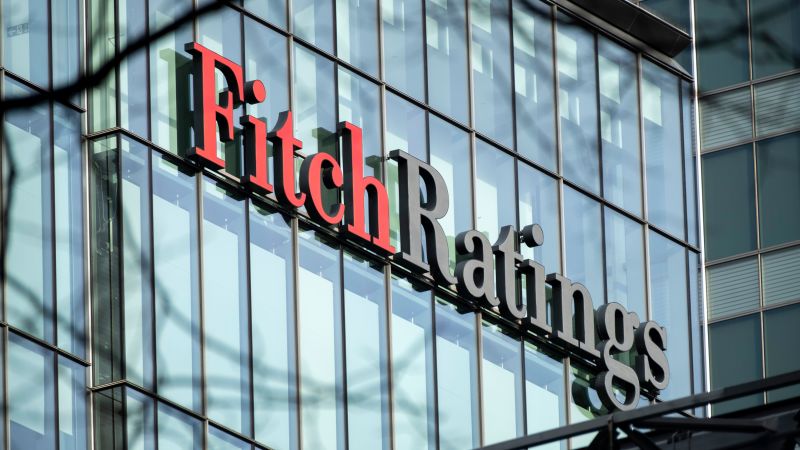I published on Western Midstream Partners (NYSE:WES) in early April. A lot has happened since including yesterday’s announcement of Occidental Petroleums’ (OXY) partial sale. Through the secondary public offering, OXY will sell 19M (with an option of an additional 2.85M) limited units of the approximately 194M total it owns. The offering price remains unknown at the time of writing. WES will neither issue any additional units nor receive any proceeds from the sale.
I consider all recent developments including yesterday’s announcement bullish for WES and its long-term unitholders. The post assumes readers’ familiarity with WES operations and structure.
Occidental’s partial sale
In February, Reuters reported that Occidental Petroleum (OXY) is exploring a sale of WES to slash its debt. As a reminder, OXY owns ~49.8% of WES including its general and limited partner units, and simultaneously is, by far, the biggest WES customer. WES CEO Michael Ure, in charge since 2019, used to work for OXY. Even though WES is technically independent, OXY’s influence is difficult to overestimate.
Several analysts and many WES investors took the Reuters report seriously – please see my previous publication for details. When WES increased its distribution by 52% in February, units did not follow in sync and added only ~15% initially. The hike in distribution was ascribed to OXY’s ploy to pump up WES units before initiating the sale. Some even suggested that the new distribution level is unsustainable.
In my previous post, I argued that the new distribution is sustainable but the hike’s aggressiveness implied OXY’s involvement. My opinion remains intact. Now OXY will either conduct a partial sale of its WES units or gradually sell all its stake. For the reasons below, I guess it is the former.
On the last OXY earnings call, CEO Hollub made the following statement:
Beyond oil and gas, we expect our OXYChem and midstream businesses to continue to provide material cash flow durability in the years ahead.
Ms. Hollub would have hardly said it were she entertaining plans for a full sale of WES in the foreseeable future.
The numbers support the same conclusion. Occidental has just closed its long-pending CrownRock acquisition financed partially by a new debt of ~$9.7B issued in July consisting of $4.7B in term loans and $5B in unsecured notes. This resulted in a long-term debt load of ~$28B. To strengthen its balance sheet, OXY committed to quickly slashing its debt through a series of asset sales and divestitures.
Occidental Petroleum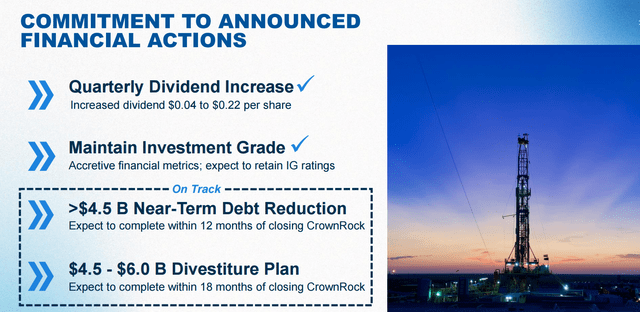
Per the recent earnings call, by the end of Q3 and without the just announced partial sale of WES units, OXY will have completed ~$3B of its $4.5-6B divestiture plan within 18 months of closing CrownRock. The remaining $1.5-3.0B is much smaller than the full OXY’s stake in WES worth ~$7.5B.
Finally, if OXY wanted to dispose of WES completely, its full 49.8% stake would attract a higher bid from a corporate buyer be it Berkshire Hathaway (BRK.B) (we know that Ms. Hollub flew to Omaha to visit Mr. Buffett, the biggest OXY’s stakeholder, before OXY announced its CrownRock acquisition), another midstream company or private equity. Moreover, a full sale of the WES stake would be sufficient to strengthen OXY’s balance sheet without the need for other divestitures.
I would not mortgage my house on it, but most likely, OXY will keep its WES stake without (or with minor) changes. It makes sense since WES is distributing plenty of valuable cash to OXY (~$600M annually at the current rate and AFTER the partial sale) and is expected to increase its distributions in the coming years.
For retail long-term investors, it does not matter much whether OXY will keep all its remaining stake in WES or continue its gradual sale. Both scenarios make unlikely a sale of OXY’s full stake to a single corporate buyer that could potentially lead, one way or another, to taking WES private.
This is a welcome piece of news. Receiving substantial, growing, and tax-deferred distributions coupled with related capital appreciation over many years is preferable to pocketing a one-time sale premium. A possibility of taking WES private might have also kept a lid on unit prices.
The announcement of OXY’s sale may cause a temporary weakness in WES – I do not know it as am writing before the market opening. In my opinion, it could be an opportunity to buy.
Strong Q2 performance
We will now turn to fundamentals. For WES, cash flow from operations (“CFFO”), free cash flow (“FCF”), and adjusted EBITDA are the most important performance numbers. Due to the nature of its long-term fee-based contracts and limited seasonality, it makes sense to compare numbers on a quarter-to-quarter basis.
WES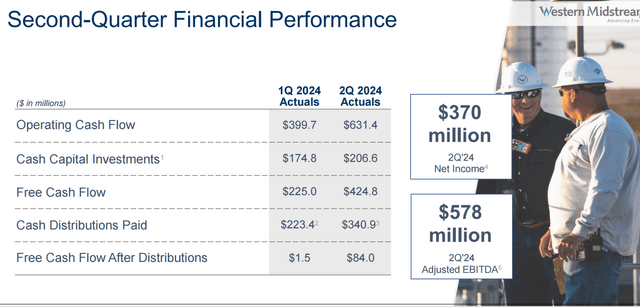
WES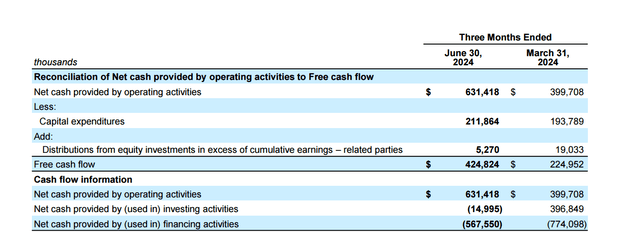
FCF jumped almost two times from Q1 to Q2 despite divesting certain non-core (non-controlled equity investments) assets in Q1-Q2. The effect of these divestitures led to a decrease in Natural Gas and Crude Oil and NGL throughputs shown on the slide below:
WES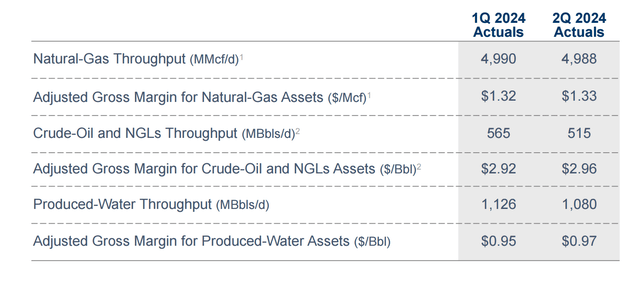
However, a decrease in the slide masks increases in throughputs from its core assets which the company projects to continue for the rest of 2024.
So, what drove the increase in cash flows? As follows from Q2 10-Q, it is primarily changes in working capital (to be reversed in subsequent quarters). Correspondingly, accrual adj. EBITDA has marginally decreased due to asset sales partially offset by an increase in throughputs from the core assets:
WES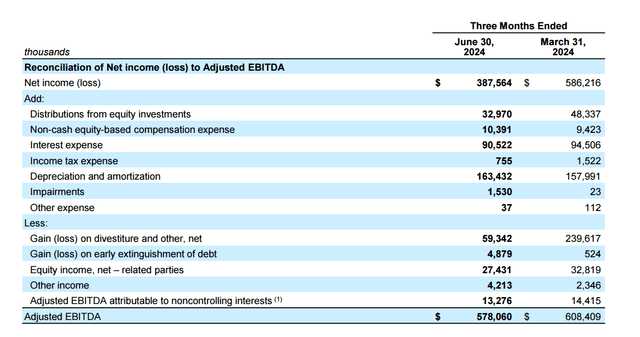
WES has left its forecast for the full year unchanged but the company now expects its result close to the top range of its forecast.
WES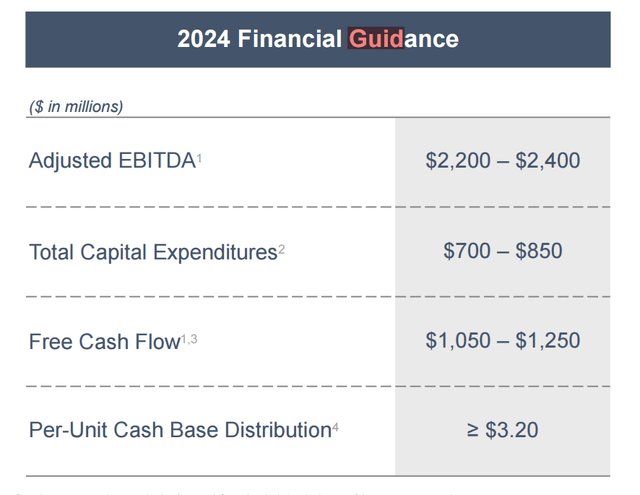
In H1, WES produced FCF over its Base Distributions which may lead to Enhanced Distributions for 2024 payable in Q1 2025. More importantly, short of something extraordinary, investors should be reasonably confident that WES will deliver its committed Base Distributions for 2024. Quite a few analysts and investors were in doubt about it in February after a 52% increase.
Stronger balance sheet
At the end of Q2, the company achieved its target of Net Debt/adj. EBITDA=3.0
WES
It may lead to several positive consequences:
- WES will have more flexibility in pursuing possible M&A – Mr. Ure indicated it on the earnings call. As we will show shortly, it may become quite important.
- WES will have more flexibility in continuing to raise its distributions.
- It increases chances for 2024 Enhanced Distributions as they are payable only if leverage is below 3.0.
- With time, credit agencies may upgrade their ratings. Currently, WES has BBB- ratings but its leverage is on par with Enterprise Partners (EPD) rated A-. While EPD is a much larger and better diversified MLP, the difference in credit ratings of 3 notches at the same leverage seems too big. WES long-term bonds have moved up since my first publication (I purchased bonds maturing in 2048 together with units). A credit upgrade should decrease WES’ cost of capital which will be handy for M&As.
A flurry of new commercial agreements
It is unusual to see so many during a quarter and will not recur. Without the full list, they are referred to on one of WES’ slides:
WES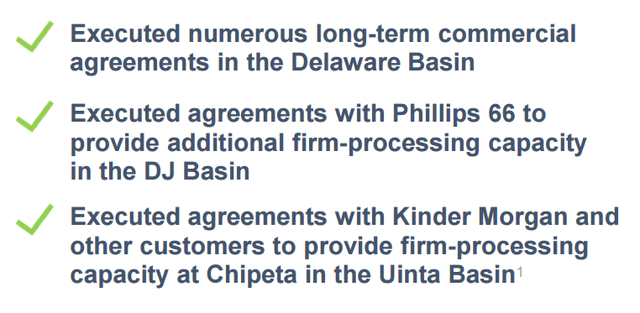
The new agreements will increase 2024 numbers only marginally but provide accretion to cash flows in 2025 and beyond. Many of them will better utilize existing assets with no or little Capex.
Possible CrownRock acquisition consequences
WES did not even mention this acquisition on its earnings call as it does not have assets in Midland where CrownRock is operating. However, OXY and WES may attempt to start midstream operations in Midland via a reasonable acquisition over the next several years. Provided OXY will keep the remaining stake in WES, the synergy with major OXY operations in productive Midland may be too alluring to ignore.
Valuations
For an investment-grade issue, WES yield remains attractive at ~3.50/37~9.5% on a forward basis. And there are arguments for strong distribution growth in 2025 and beyond:
- Possible Enhanced Distributions in 2024. Based on excess FCF in H1, it may be about 12% of Base Distributions.
- CFFO should grow in 2025 because of the full year for the Mentone III gas processing plant, the planned commissioning of the North Loving gas plant in Q1 25, accretion due to new commercial agreements, and lower interest expenses. The same factors (except for Mentone III) should cause further growth in 2026.
- Capex is expected to drop after the North Loving plant commissioning causing FCF growth beyond CFFO growth. On the Q1 earnings call, Mr. Ure mentioned a ~$200M drop in Capex equal to a ~20% increase in FCF and a similar one in distributions. On the Q2 call, Mr. Ure did not mention this number again since some of the new commercial agreements will require Capex. Nonetheless, he confirmed that Capex is expected to drop.
- Possible M&As though it is a double-edged sword for distributions. The company mentioned M&As so many times on the Q2 earnings call that negotiations may already be beyond initial probing.
We do not have the company’s forecast for 2025 yet which makes any number for the distribution increase highly speculative. However, on the Q2 call, the company emphasized the importance of this increase quite a few times. In this regard, OXY’s thirst for cash should not be underestimated. Looking at the bullets above, I would not be surprised to see 2025 increase (for a combination of Base Distributions and Enhanced Distributions for 2024) to reach 20% without M&As.
On an EBITDA basis, WES is less attractive. My previous article concluded that WES deserves at least a 9.6 multiple based on sales of inferior assets as comps. Assuming the 2024 EBITDA high-end projection of $2400, we calculate EV=2400*9.6=23,040. With a net debt of $6,871, it translates into a WES unit value of (23040-6,871)/389.6 ~ $41.50 towards the end of 2024. Discounted to the present value it is equal to the current WES price.
On each earnings call, WES mentions it is undervalued. They use multiple arguments to support this claim and one of them refers to the comparison between “old” and “new” MLP models in terms of EBITDA multiples as displayed on the slide:
WES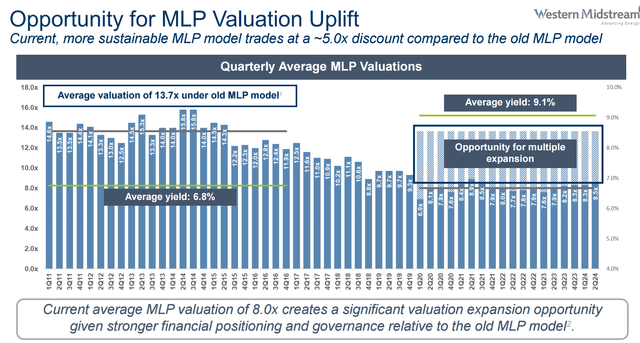
The major difference between the “old” and “new” MLPs is internal Capex financing (without issuing new units), no incentive distribution rights for general partners, and lower leverage. Consequently, WES argues that rerating for MLPs is overdue.
These are valid arguments but the situation is more complex. “Old” MLPs were operating when the green movement was not that strong yet (say, in 2011-12), and crusades against oil and gas were not that advanced.
When I analyzed EPD three years ago, I tried to account mathematically for the influence of greens. It resulted in an approximately 20% drop in value for midstream companies. Two things have happened since.
First, the war in Ukraine and related sanctions have made US oil and gas more valuable. Secondly, the quick rise of AI has increased energy demand drastically. And in my opinion, this demand is not limited to only green sources. There is no hard border between oil and gas and renewable sources as there is too much overlap. Energy consumption should increase across sources and make oil and gas companies more valuable.
These two positives seem to be ignored so far as on the slide above, the valuations have not changed noticeably since 2022. I am not sure the opportunity for multiple expansion is as big as WES depicts it, but it might be real.
Conclusion
Investing in WES appears particularly appealing if we look beyond 2024. The progress seems very probable and the management keeps hinting at it albeit without numerical forecasts so far. This is the same management that has delivered exceptionally well since 2019 when Occidental acquired Anadarko including future WES. Their words deserve some credit, especially since CEO Michael Ure owns more than half a million units worth ~$20M based on the latest filing.
At the same time, I do not see particular risks (beyond regular risks of investing in equities) in buying an investment-grade midstream company with an almost 9.5% tax-deferred yield precisely when energy becomes more valuable.
Read the full article here
